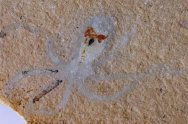Styletoctopus
annae
Phylum Mollusca,
Class Cephalopoda, Superorder Octopodiformes, Order Octopoda, Octopodidae
Geological
Time: Middle Cretaceous, Cenomanian Stage (95 million years ago)
Size: Fossil
is 40 mm across
Fossil
Site: Lebanese Lagerstätte,
Haqel (or Hâkel), Lebanon
 Description:
Here is a rare fossil from the Cretaceous Lagerstätte in
Lebanon in North Africa. Fossil octopi are rare in the fossil
record in
large part because they lack either an internal or external skeleton.
Thus, the detail seen here requires preservation of soft tissue
of the type only rarely seen and usually only found in fossil
sites meeting the criteria for Lagerstätten. The genus
name comes from its stylets, vestigal shells (i.e., greatly
reduced from the original ancestral forms)
found within
the
soft tissues only some octopus groups.
This fossil exhibites pretty amazing preservation with details
of many soft tissue parts present, with the arms mantle and head
preserved in fluorapatite (a phosphate mineral with the formula
Ca5(PO4)3F), the orange stain showing some of the internal organs,
and the ink
sac preserved
in three dimensions. There are two enhanced contrast photos below
with enhanced contrast to better show details, as well as a
sketch to aid in interpretation. Description:
Here is a rare fossil from the Cretaceous Lagerstätte in
Lebanon in North Africa. Fossil octopi are rare in the fossil
record in
large part because they lack either an internal or external skeleton.
Thus, the detail seen here requires preservation of soft tissue
of the type only rarely seen and usually only found in fossil
sites meeting the criteria for Lagerstätten. The genus
name comes from its stylets, vestigal shells (i.e., greatly
reduced from the original ancestral forms)
found within
the
soft tissues only some octopus groups.
This fossil exhibites pretty amazing preservation with details
of many soft tissue parts present, with the arms mantle and head
preserved in fluorapatite (a phosphate mineral with the formula
Ca5(PO4)3F), the orange stain showing some of the internal organs,
and the ink
sac preserved
in three dimensions. There are two enhanced contrast photos below
with enhanced contrast to better show details, as well as a
sketch to aid in interpretation.
Also see:
Fuchs, D.; Bracchi, G.; Weis, R. (2009). "New octopods
(Cephalopoda: Coleoidea) from the Late Cretaceous (Upper Cenomanian)
of Hâkel and Hâdjoula, Lebanon", Palaeontology
52: 65–81 |
|






